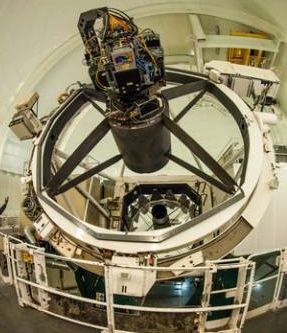
17/06/2015
First light for PAU camera, designed to study dark energy
First light for PAU camera, designed to study dark energy
About the composition of the universe, physicists are sure of one thing: their ignorance. Indeed, if 5% of the universe is made of well known atoms, the remaining 95% are made of both unknown matter (the so-called dark matter, 25%) and unknown energy (the so-called dark energy, 70%) that explains why the expansion of the universe is accelerated.
To know more about this energy, the Physics of the Accelerating Universe (PAU) Spanish project is based on the development of a special camera built with the participation of IFAE (project leader), IEEC and PIC, all three on the Universidad Autónoma de Barcelona (UAB) campus, the key Barcelona Synchrotron Park partner.
The camera was successfully installed on the William Herschel telescope at the Observatorio del Roque de los Muchachos (ORM) on La Palma-Canary Island on June 3. The tool is especially designed to precisely measure the distance between galaxies and thus study how universe expands at an ever faster pace.
The PAUcam was designed and built in six years by a consortium of institutions that includes the Institute for High Energy Physics (IFAE), the Institute for Space Sciences (ICE-CSIC/IEEC), the Scientific Information Centre (PIC), all three on the UAB campus, and the Centre for Research in Energy, Environment and Technology (CIEMAT) and the Institute of Theoretical Physics (IFT-UAM/CSIC).
To know more about this energy, the Physics of the Accelerating Universe (PAU) Spanish project is based on the development of a special camera built with the participation of IFAE (project leader), IEEC and PIC, all three on the Universidad Autónoma de Barcelona (UAB) campus, the key Barcelona Synchrotron Park partner.
The camera was successfully installed on the William Herschel telescope at the Observatorio del Roque de los Muchachos (ORM) on La Palma-Canary Island on June 3. The tool is especially designed to precisely measure the distance between galaxies and thus study how universe expands at an ever faster pace.
The PAUcam was designed and built in six years by a consortium of institutions that includes the Institute for High Energy Physics (IFAE), the Institute for Space Sciences (ICE-CSIC/IEEC), the Scientific Information Centre (PIC), all three on the UAB campus, and the Centre for Research in Energy, Environment and Technology (CIEMAT) and the Institute of Theoretical Physics (IFT-UAM/CSIC).
More news
16/09/2014
SENER awarded its first contract with Embraer
09/09/2014
From brick to neuron
02/09/2014
The UAB University is strengthening its position in the Shanghai ranking
27/08/2014
Ascamm develops a drone for rescues
20/08/2014
SENER and ESA reach an agreement for the prime contractor role on the Proba 3 mission
06/08/2014
The Catalan Institute for Nanoscience and Nanotechnology receives the Severo Ochoa accreditation









